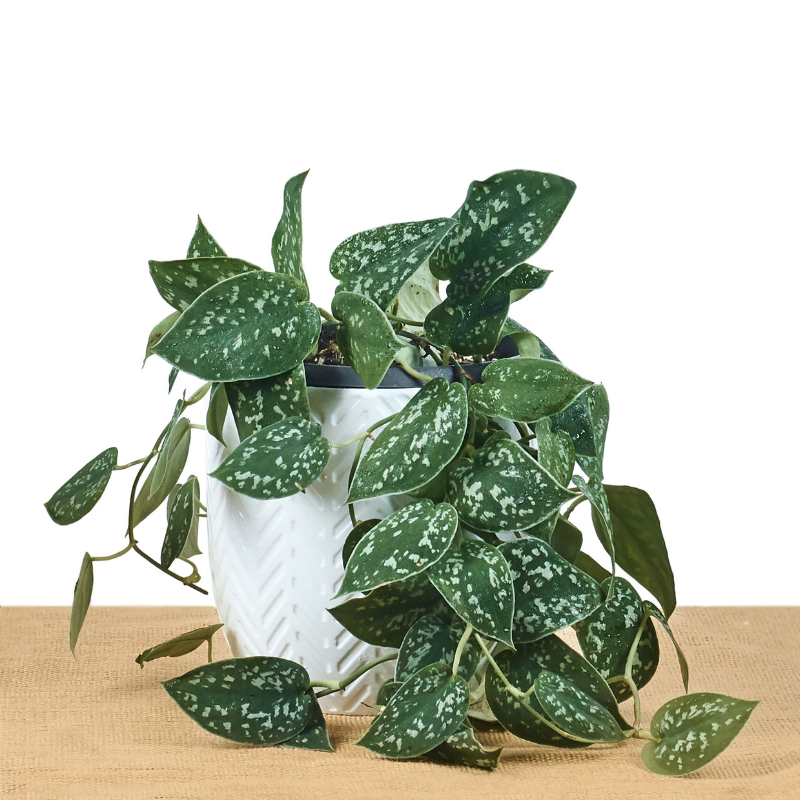Did you see how lovely pothos plants decorate a home or garden when trained to climb, and you want to replicate it as well? As a pothos plant owner, it is advised that you replicate how your pothos plant variety grows in the wild, to help it climb better.
Naturally, pothos plants do not climb, unless something is prompting them. Instead, they are referred to as trailing or dangling houseplants. Thus, to train your pothos to climb, you need an anchor to prompt the process.
To train pothos plants to climb, you need to attach its aerial roots to anchoring systems, such as poles, bamboo canes, wires, or trellises. Pothos can latch onto walls as well, and bright glow lights help them climb, as they naturally grow towards the light.
Fortunately, all pothos plant varieties can be trained to climb, with the right techniques, anchoring system, and proper lighting, all would be discussed further in the article.
9 Easy Steps To Help Train Pothos Plants To Climb
The foremost advice to give when training your pothos plant to climb is to allow it to grow (i.e in one or two years), till it’s a long-haired plant. The roots/stems are stronger, its leaves are mature and magnificent, and it can easily adapt/ climb to any support system.
The next step is, to use the right kind of anchor system that would encourage your plant to climb. The frequently used support systems are:
- Poles: moss poles
- Totem poles
- Metal poles or industrial pipe
- Bamboo canes
- Walls latched with wires or lights
- Wooden trellises
- 3M command hooks
- Wires
- Picture frame hooks.
Here are 9 simple steps to help train your pothos plants to climb in your home or garden:
1. Pothos Plant Thrive In Proper Lighting and Temperature Conditions
Ensure to climb your pothos in an area, with bright indirect lighting, balanced humidity, and an ideal temperature of 70-75°F.

2. Place Your Climbing Pothos In The Right Soil
Your climbing pothos needs to be planted in quality well-draining soil potting mix, also in a right-sized pot. Ensure the pot has drainage holes at the bottom, to optimize space and growth.
3. Train To Climb After It’s Matured
It is best to allow your pothos, to grow in their early years before training them to climb. As pothos are naturally trailing houseplants, it helps to allow them to trail and their leaves are big enough. This would give you strong, firm, luscious pothos when trained to climb.
4. Ready The Tools Needed
Now that you know the basics, the next step is to get the equipment needed ready. Here’s a quick list of the tools you’ll need to train a pothos to climb:
- A potted pothos plant.
- The support or anchor system, (i.e trellis, poles, bamboo canes, command hooks, or picture hangers). Choose one that’s suited in with your plant variety and home décor.
- It helps to use string to support the weight of your plant.
- Sterile sharp scissors.
5. Add Your Preferred Support To The Potted Plant
If you’re using wire support, use picture hangers or command hooks to latch them onto the wall. For a trellis, attach it against the wall or in the pot for stability.
For the moss pole, soak or mist it with little water, then wrap the longest vine at the back or the middle of the plant. While for string or bamboo canes, you can create a lattice (grid) for your pothos to climb. Or when using a stake, ensure to place it in the pot, in an area that’s not visible, but the plant’s vine can reach it.
Take Note: To wrap your plant on its support system, just an inch above its leaf node, to encourage new growth.
6. Start Tying Your Pothos Vines
Once you’ve secured your support in place, you can start training your pothos to climb, by gently tying the vines to the support with string. Ensure to gently the vines until it is securely wrapped. You can also opt to use plant ties, which can be found at garden stores.
7. Carefully Prune When Needed
If your pothos plant vines have become too large to tie to the support itself, you can trim those vines so that they’re shorter and easier to use. Just be careful not to trim off too many vibes, as they’re needed to help the pothos climb.

8. Fertilize As Needed
Pothos plants thrive when fertilized, it is advised to feed your plant 2-4 times a year, especially during its growing season (i.e in spring and fall). Here’s a list of the best fertilizers for houseplants.
9. Keep Maintaining Your Climbing Pothos
As the plant grows, continue to tie it to the support and trim the vines when overgrown. You can opt to add additional support systems as needed, and then watch your beautiful pothos plant climbing up your trellis or walls.
Do pothos like to climb
Yes, pothos can both climb or hang on surfaces. As trailing houseplants, they can latch to walls, poles, and trellis, as well as a dangle from hanging baskets.
How long does pothos take to trail?
During its active growing season, pothos can grow 12 inches per month, which is from December to May. Thus, within 2-3 months, your pothos should’ve grown long enough to start trailing.
Why is pothos not vining?
The most common reasons for pothos not growing is lack of enough lighting, nutrients, humidity, stress, or pests and diseases. Pothos needs good living conditions and bright indirect light to grow properly.
Does pothos need a pole?
Once you use a climbing pothos plant, poles especially moss poles are a great way to help your pothos climb speedily and still retain their nutrients.
Conclusion
Pothos are highly prolific, versatile, and easy to maintain houseplants. They are loved in many homes for their simplicity, beauty, and low-maintenance care from its owners. With its versatility, it can both trail or climb to help beautify and decorate your home.
Take note to gently tie the plant’s vine until it’s securely wrapped, with your preferred anchoring system, and do this an inch above its leaf node, to encourage new growth.
Following each step correctly, enjoy the view of your climbing pothos either with a pole, trellis, picture frame, string, or onto the wall.

